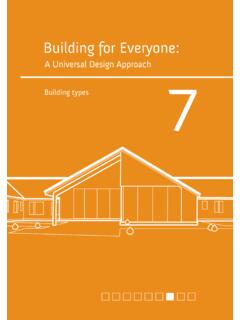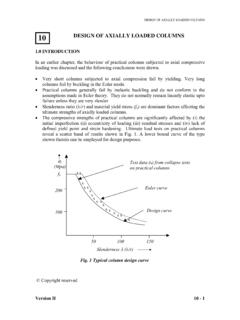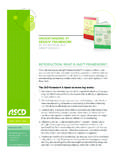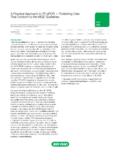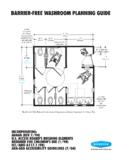Transcription of Vol. 29, No. 4, pp. 326-341 Impacting Patient Outcomes ...
1 Impacting Patient Outcomes through design : acuity adaptable Care/ universal Room design By Katherine Kay Brown, MSN, RN, CCRN, and Dennis Gallant, BSID To succeed in today s challenging healthcare environment, hospitals must examine their impact on customers patients and families staff and physicians. By using competitive facility design and incorporating evidence-based concepts such as the acuity adaptable care delivery model and the universal room, the hospital will realize an impact on Patient satisfaction that will enhance market share, on physician satisfaction that will foster loyalty, and on staff satisfaction that will decrease turnover. At the same time, clinical Outcomes such as a reduction in mortality and complications and efficiencies such as a reduction in length of stay and minimization of hospital costs through the elimination of transfers can be gained.
2 The results achieved are dependent on the principles used in designing the Patient room that should focus on maximizing Patient safety and improving healing. This article will review key design elements that support the success of an acuity adaptable unit such as the use of a private room with zones dedicated to patients , families, and staff, healing environment, technology, and decentralized nursing stations that support the success of the acuity adaptable unit. Outcomes of institutions currently utilizing the acuity adaptable concept will be reviewed. Key words: acuity adaptable , decentralized nurse stations, evidence-based design , facility design , healing environment, universal bed The existing healthcare environment and current Patient clientele are compelling hospitals to abandon the traditional conveyor belt approach to care where patients are transferred from unit to unit in search of the proper level of care.
3 Aging baby boomers, who own 75% of the wealth in this country, are savvy consumers who enjoy creature comforts, luxury items, and superior Accounting for two thirds of all dollars spent on healthcare, with differing expectations than generations past, baby boomers are demanding a holistic approach to care that focuses on psychosocial as well as medical needs and are expecting services to be provided in a hotellike At the same time, because of aging baby boomers, patients are sicker with more comorbidities requiring more technologically complex care during their entire hospital stay. At an average age of 47, nurses are imbedded in this group of boomers and a significant number will be retiring from the profession. Because of stressful working conditions, predictions continue to forecast an overall shortage of qualified caregivers and young people entering the nursing profession.
4 Thus, the future inpatient landscape will reflect increasing numbers of higher acuity patients being cared for by a shrinking pool of aging In addition, payers are continually forcing hospitals to reduce length of stay. Nurses and physicians are charged with providing more intense care and meeting the Patient s needs during an abbreviated time span. The intensity of care is expected to increase as about 10% to 13% of beds today are designated for critical care patients and this number is expected to increase to 20% to 30% in the In response to the current environment, hospitals and planners have begun exploring options that can address this undercurrent of change and enable hospitals to prosper and provide quality care into the future. What has emerged is recognition that to survive into the future will require facilities, infrastructure, and technology that are more flexible and adaptable to change than ever before.
5 Energies must be focused on creating flexibility for the future where it impacts the Patient most the hospital Patient room. acuity adaptable AND universal Patient ROOMS Over the past 8 years, a number of pioneering hospitals have been constructing new room designs intended to provide longterm flexibility and safe Patient care based on the acuity adaptable and universal Room concepts. The acuity adaptable and universal Room models have been implemented in a number of hospitals and are beginning to provide valuable lessons for future hospitals and care practices. As these concepts have matured, their application and purpose have evolved and, in some cases, become interconnected. Sometimes these concepts have been expressed as serving the same purpose, when in fact they serve distinct purposes. acuity adaptable The acuity adaptable concept has evolved as a means of maintaining the Patient in the same Patient room or nursing unit from admission until discharge, regardless of the Patient s level of acuity .
6 The required level of care is brought to the Patient instead of having the Patient endure multiple transfers. acuity adaptable beds minimize bottlenecks and delays in the Patient flow because of the unavailability of the correct level of care. Utilizing this model of care delivery requires combining critical care staff with progressive or medical-surgical nursing staff to eliminate hand-offs and provide a more seamless comprehensive care practice. An early pioneer of the acuity adaptable concept was Loma Linda University Medical Center in California. In the late seventies, this facility implemented a practice of aggregating and maintaining its cardiothoracic patients in the same unit through its entire course of stay until discharge. The facility determined that Patient transfers introduce a number of disruptions to safe Patient care and impose a significant amount of additional work on nursing staff and hospital In the early 1990s, MedCath, a nationwide group of physician-owned, specialty heart hospitals, embraced eliminating transfers of their cardiac patients in the newly constructed facilities.
7 In addition, the design of these new 40- to 50-bed heart centers incorporated standardized or universal room designs. Patient rooms throughout the hospital shared a uniform design and were equipped with the appropriate cardiac care technology and capable of handling any type of cardiac Patient , to help maximize flexibility and facility As seen in Critical Care Nursing Quarterly Vol. 29, No. 4, pp. 326-341 More recently, community hospitals initiating open-heart surgery programs in regions where tertiary institutions have been performing cardiac surgery for years have gravitated to the acuity adaptable concept. They feel that they are able to better compete by marketing such a Patient -centered care approach to the consumer. In addition, they believe that the ability to adjust the room and its resources within minutes ensures that patients fluctuating or episodic clinical needs will be promptly addressed with minimal disruption for them of the staff.
8 In 1999, Clarian Health System s Methodist Hospital in Indiana opened a 56-bed comprehensive cardiac critical care (CCCC), which maintained its cardiac medical patients in the same room until discharge. This pioneering project incorporated many innovative concepts such as distributed nursing stations and family zones that better supported the single stay model of care and was one of the first institutions to methodically collect data and document the impact of the acuity adaptable concept on Patient and efficiency In fall of 2004, The Ohio State University (OSU) Medical Center opened the Richard M. Ross Heart Hospital, an acuity adaptable 90-bed hospital, offering the full spectrum of cardiovascular services from interventional cardiology to cardiac surgery and transplantation. It is the first comprehensive academic dedicated cardiovascular hospital fully integrated with the OSU Medical Center, including the Dorothy M.
9 Davis Heart and Lung Research Institute, and the OSU College of Medicine and Public Health. The academic medical center setting not only provides the highest level of research-based, quality care but also allows for an outstanding educational opportunity for students to experience the acuity adaptable model of Patient care The success of the acuity adaptable concept has spurred other institutions to utilize this care approach for their general and vascular surgery patients and even neurology and neurosurgery From a clinical perspective, all Patient populations can benefit from the acuity adaptable concept, but economically building this type of room for Patient populations who tend not to utilize intensive care unit (ICU) services may not be feasible. However, adaptations in room design would be able to accommodate most Patient acuities.
10 A hospital in the Midwest is building a 200-bed facility with 149 acuity adaptable rooms to accommodate the majority of inpatients and 18 superintensive care beds to meet the needs of only the most severely ill patients such as those with multiple universal room In comparison, the universal Room concept shares similar characteristics to the acuity adaptable concept but operates in a traditional clinical manner with patients being transferred between units and levels of care. As the acuity and complexity of the entire inpatient population grows, hospitals that are remodeling or expanding have begun to task the design community to create Patient rooms that are universal or flexible enough to accommodate the increasing Patient acuity over time. The high cost of construction projects is likewise causing hospital administrators to seek building solutions that would not be obsolete and require reinvestment within a decade of opening.



